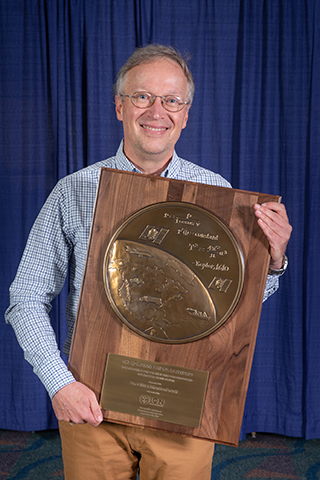Dr. Todd E. Humphreys, known for his fundamental contributions to secure, precise and robust PNT and GNSS software-defined receivers (SDR), received this year’s Johannes Kepler Award. The Institute of Navigation’s (ION) Satellite Division recognized Dr. Humphreys with this prestigious honor, the highest it bestows, during the ION GNSS+ 2023 conference in Denver.
Dr. Humphreys, who holds the Ashley H. Priddy Centennial Professorship in Engineering in Aerospace Engineering and Engineering Mechanics at the University of Texas at Austin, was honored for his “sustained contributions to the art and science of navigation signal processing” and “increasing the public awareness of the vulnerability of GNSS,” according to a news release.
He developed the first GNSS SDR on a small general-purpose processor that can continually track dozens of signals in real time. This C++-based receiver is a highly optimized science-grade multicore GNSS SDR—and the first of its kind to demonstrate centimeter-accurate GNSS positioning with a smartphone antenna.
Through his publications on assessing the threat of civilian spoofers, he initiated the study of GNSS security in open literature. Dr. Humphreys designed and studied diverse methods to detect and counteract spoofing attacks and developed standardized test conditions to evaluate GNSS signal authentication concepts. Because of his work, more people now understand the risks associated with GNSS spoofing and jamming. His live demonstrations and public addresses, which include testifying before Congress and participating in international advisory boards, have helped to increase awareness of GNSS vulnerability beyond the PNT community.
Dr. Humphreys also helped accelerate the movement to carrier-phase-based GNSS into the mass market.
“His laboratory was the first to demonstrate cm-accurate real-time kinematic (RTK) positioning through a smartphone antenna,” according to the release. “Dr. Humphreys laid the theoretical foundation for simultaneously mapping the signals-of-opportunity landscape and exploiting the signals and map for PNT.”
Most recently, Dr. Humphreys developed an interface specification for the Starlink signal structure to enable their use for PNT.
Dr. Humphreys directs the Radionavigation Laboratory and the Wireless Networking and Communications Group at the University of Texas at Austin. He received his BS and MS from Utah State University and his Ph.D. in Aerospace Engineering from Cornell University.
Dr. Humphreys has co-authored many technical papers for Inside GNSS, including “Pinpointing GNSS Interference from Low Earth Orbit,” which was the cover story for the September/October issue. Other Inside GNSS articles include “Robust Navigation for Urban Air Mobility,” and “Seeing and Inertial Integrating Is Believing: Multi-Antenna Vision-and-Inertial-Aided CDGNSS for Micro Aerial Vehicle Pose Estimation.”
The Kepler Award honors an individual for sustained and significant contributions to the development of satellite navigation. Past recipients include Dr. Oliver Montenbruck, Professor Peter Teunissen, Professor Terry Moore, Dr. Boris Pervan and Dr. Mark Psiaki.






